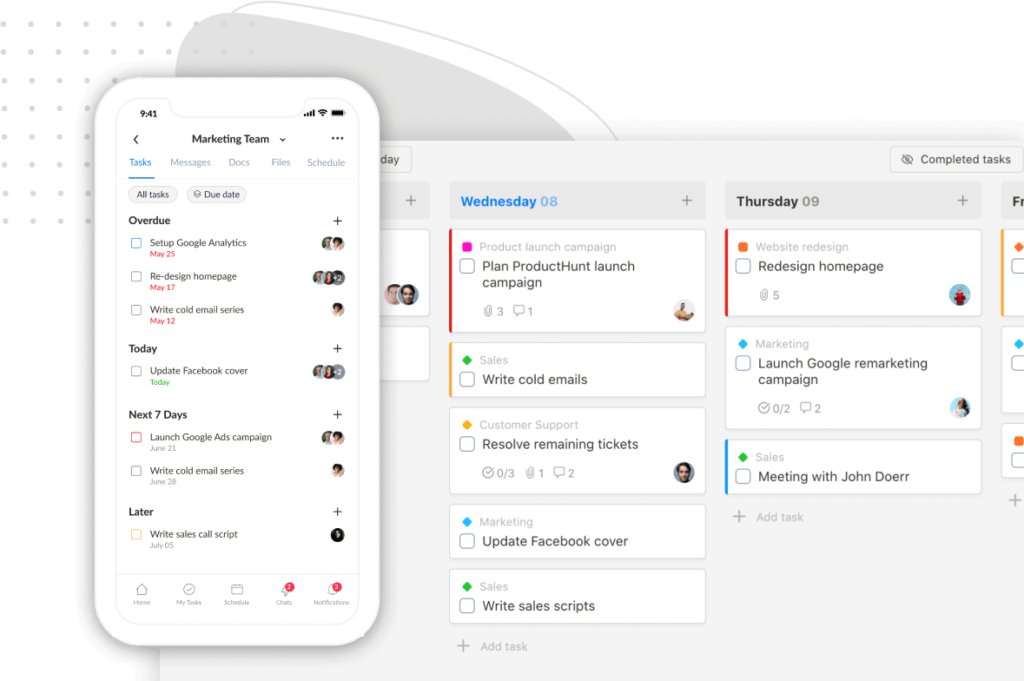Ever stare at a project to-do list that feels a mile long, with tasks seemingly tangled together?
Or maybe communication feels like a game of telephone – garbled and frustrating?
Yeah, me too. These are struggles that those juggling projects can often face.
The good news is, there’s a way to navigate these complexities and achieve successful completion. Understanding the core project management activities is the first step.
Think of these activities as a roadmap, guiding you through each phase of your project from beginning to end.
Once you master these project activities, you can effectively plan, execute, monitor, and ultimately close your projects with confidence.
So without further ado, let’s dive into this blog post.
I. Core Project Management Activities
The roadmap to project success is divided into five stages: Initiation, Planning, Execution, Monitoring and Control, and Closure.
Let’s take a closer look at what project management activities each stage involves.
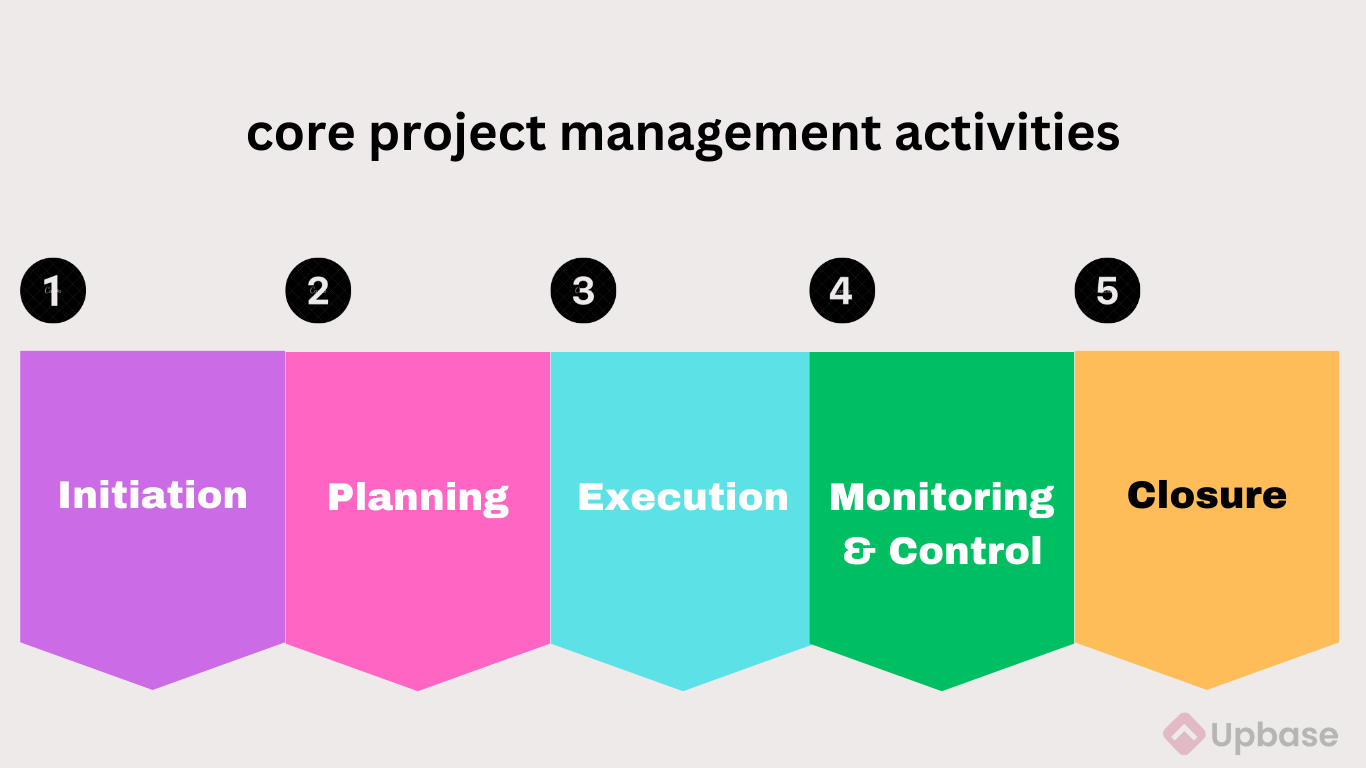
1. Initiation:
Imagine your project as a house. The Initiation stage is like pouring the foundation for everything that follows.
Consider it the “what” and “why” of your project. Here are the key activities involved in Initiation:
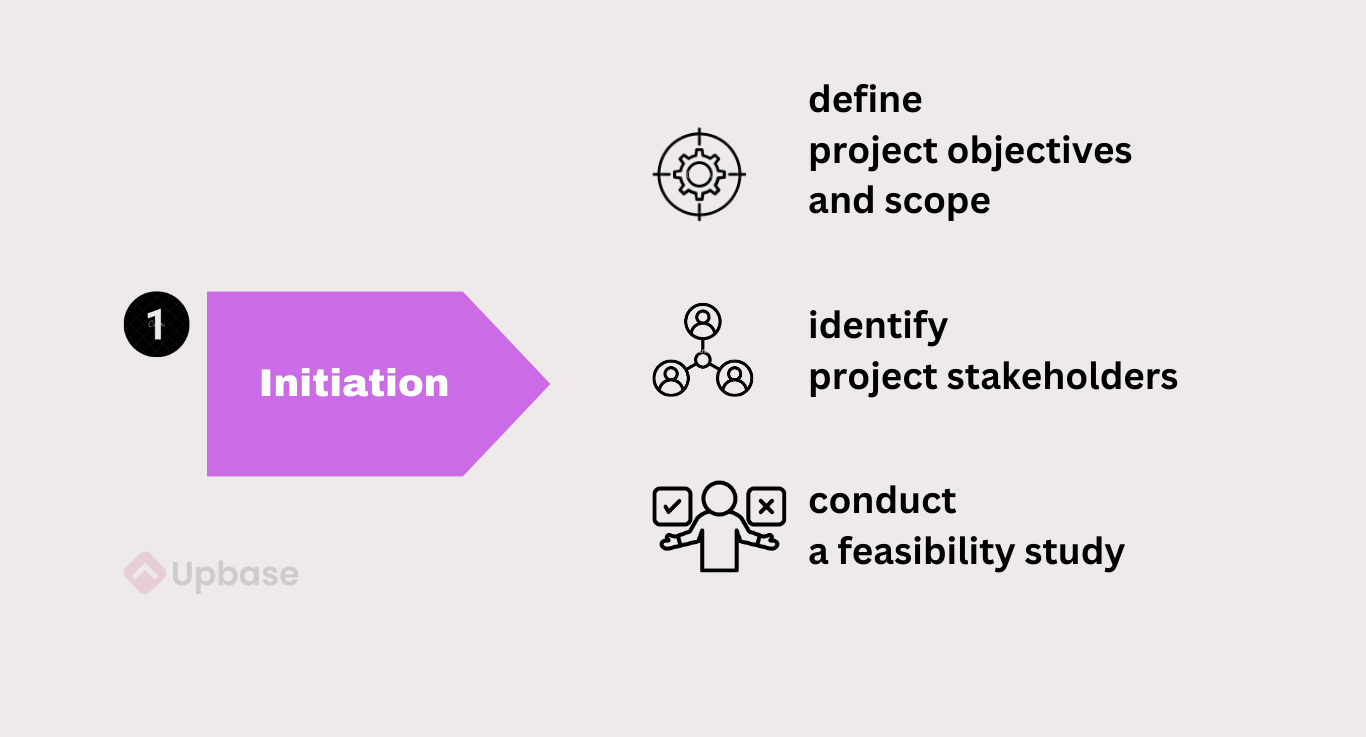
Properly Define The Project’s Objectives and Scope:
What is the project trying to achieve? What are the major project deliverable?
Clearly defining the project scope keeps everyone on the same page and helps avoid scope creep (adding features or functionalities outside the original plan) later on.
Identify Project Stakeholders:
Who has a vested interest in the project’s success? This includes anyone who will be impacted by the project, from decision-makers to end users.
Identifying stakeholders early helps ensure clear communication and buy-in throughout the project lifecycle.
Conduct a Feasibility Study:
Is this project realistic and achievable?
A feasibility study helps assess potential risks, resource requirements, and overall viability of the project before significant resources are committed.
2. Project Planning:
Alright, so you’ve laid the foundation for your project. Now it’s time to roll up your sleeves and figure out “how” to actually build the thing.
That’s the Project Planning stage in a nutshell.
Here’s what we’re gonna tackle:
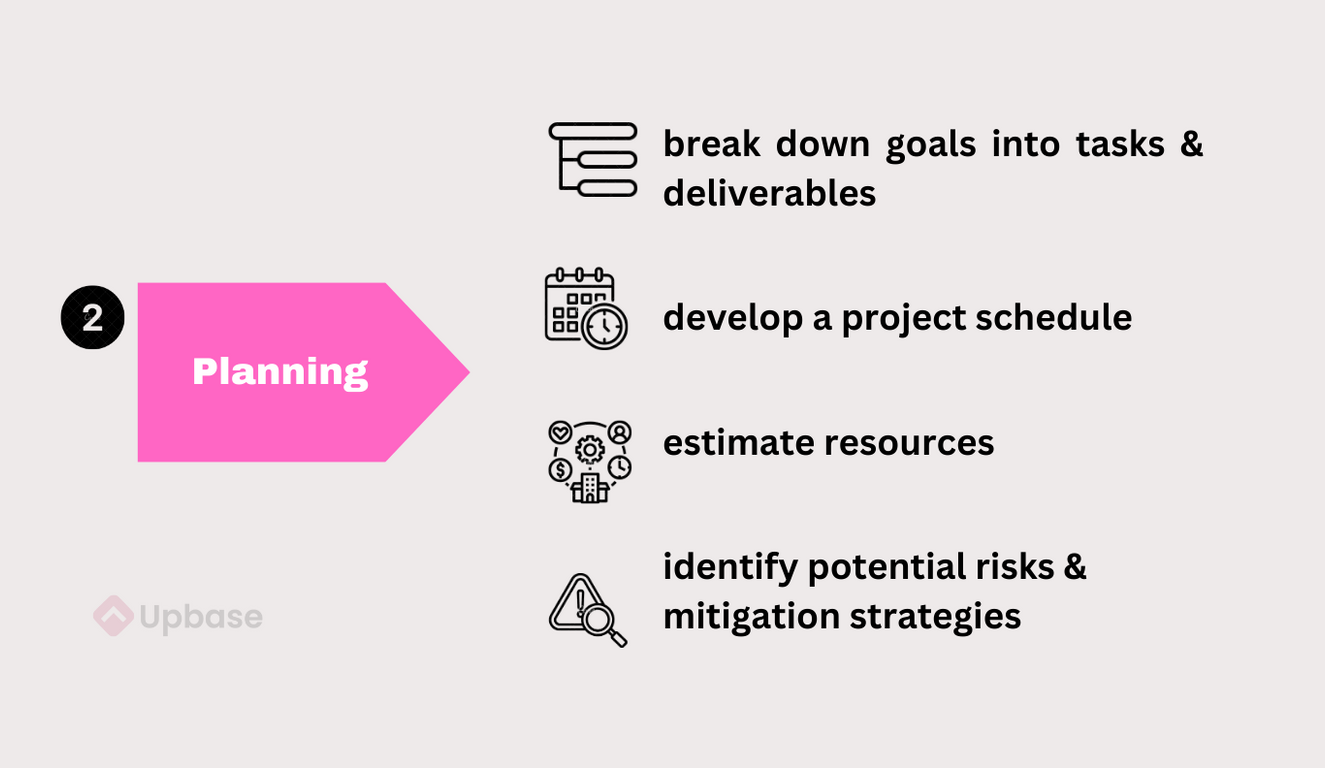
Break Down the Project Scope into Tasks and Deliverables:
Take the big picture scope you defined in Initiation and break it down into smaller, more manageable tasks. This creates a clear workflow and assigns ownership for specific deliverables (project outputs).
Develop a Project Schedule:
Map out the project timeline for completing each task.
Utilize tools like Gantt charts to visualize the project schedule and identify dependencies (tasks that need to be completed before others can start).
Here are some tips for staying on track with your schedule:
- Be realistic with time estimates for each task.
- Schedule buffer time to account for unforeseen delays.
- Regularly review and update your schedule as needed.
Estimate Resources (Budget and Personnel):
Determine the human resources (team members), time, and budget required to complete the project. This helps the project manager has the necessary internal and external resources to execute your plan effectively.
Identify Potential Risks and Mitigation Strategies:
No project is without risks.
Here, you proactively identify potential challenges that could derail your project and develop strategies to mitigate them or minimize their impact.
3. Execution:
Execution time!
This is where we take our awesome plan and make it happen – like building that house from the blueprint.
But let’s be real, this is where things can get a little messy. Remember those challenges we talked about before? Yeah, project managers often face them.
However, by following these core Execution activities, you can navigate the chaos and ensure the project’s progress goes smoothly:
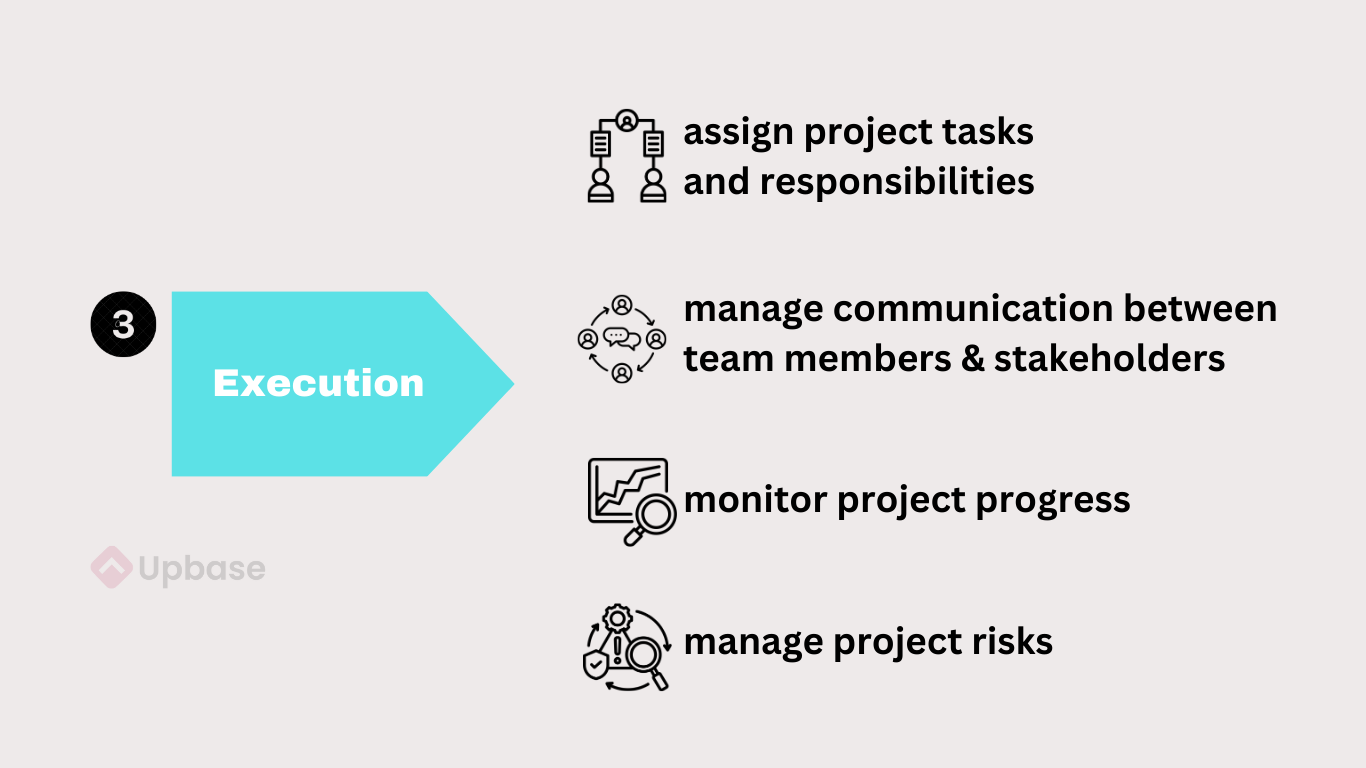
Assign Project Tasks and Responsibilities:
Delegate tasks to project team members based on their skills and expertise.
Clearly define ownership and accountability for each project task to avoid confusion and ensure everyone knows what’s expected of them.
Manage Communication Between Team Members and Stakeholders:
Open and frequent communication is vital for a successful project.
Establish clear communication channels, hold regular meetings, and proactively address any concerns or roadblocks team members or stakeholders might have.
Monitor The Project’s Progress and Identify Deviations from the Project Plan:
Track the project’s progress against the schedule and budget you defined in Planning.
This allows you to identify any deviations early on so you can take corrective action before they snowball into major project issues.
Managing Project Risks as They Arise:
Even with the best project planning, unforeseen challenges can occur. Here’s where your mitigation strategies come into play.
Proactively address project risks as they arise, and be prepared to adapt your project plan if necessary.
4. Monitoring and Control:
We’ve built the project house – now we gotta make sure it all goes smoothly! Think of the Monitoring and Control stage as the “pilot” phase.
We constantly track progress, analyze metrics, and make adjustments to keep the entire project flying smoothly toward its goals.
Here’s what that looks like:
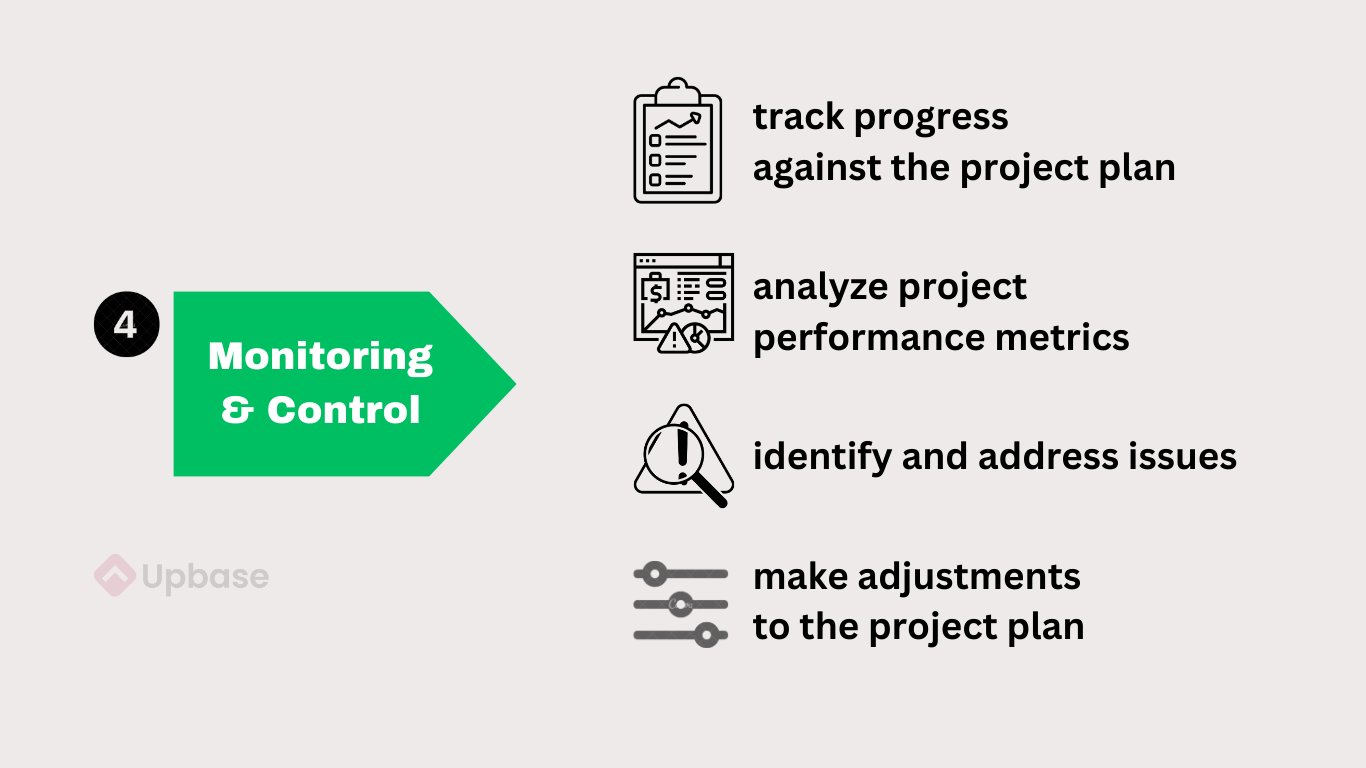
Track Progress Against the Project Plan:
Just like a pilot checks the instruments, we’ll be using project management tools to keep an eye on our schedule, budget, and how our project team is doing.
Analyze Project Performance Metrics:
Going beyond a simple to-do list, we’ll analyze key metrics, like:
- How many project tasks are getting done
- How well our team is using their time, and
- If we’re staying within budget
This allows you to take a closer look at project health and know if something needs a little adjustment.
Identify and Address Issues Proactively:
The cool thing about monitoring is we can spot potential issues early on, way before they turn into a major disaster.
Think of it like seeing a storm on the radar and adjusting course.
By addressing problems quickly, we keep the project on track and avoid any nasty surprises.
Make Adjustments to the Project Plan as Needed:
Remember, projects can change mid-flight, just like weather patterns.
Unexpected challenges or new information might mean we need to tweak our original project plan.
The Monitoring and Control stage allows us to be flexible and adapt as needed, as long as we don’t lose sight of our final destination (project objectives)!
5. Closure:
High fives all around! The Closure stage is like throwing a victory party for your project.
It’s all about wrapping things up, celebrating what you achieved, and most importantly, learning from the experience to crush your future projects.
Here’s what we do:
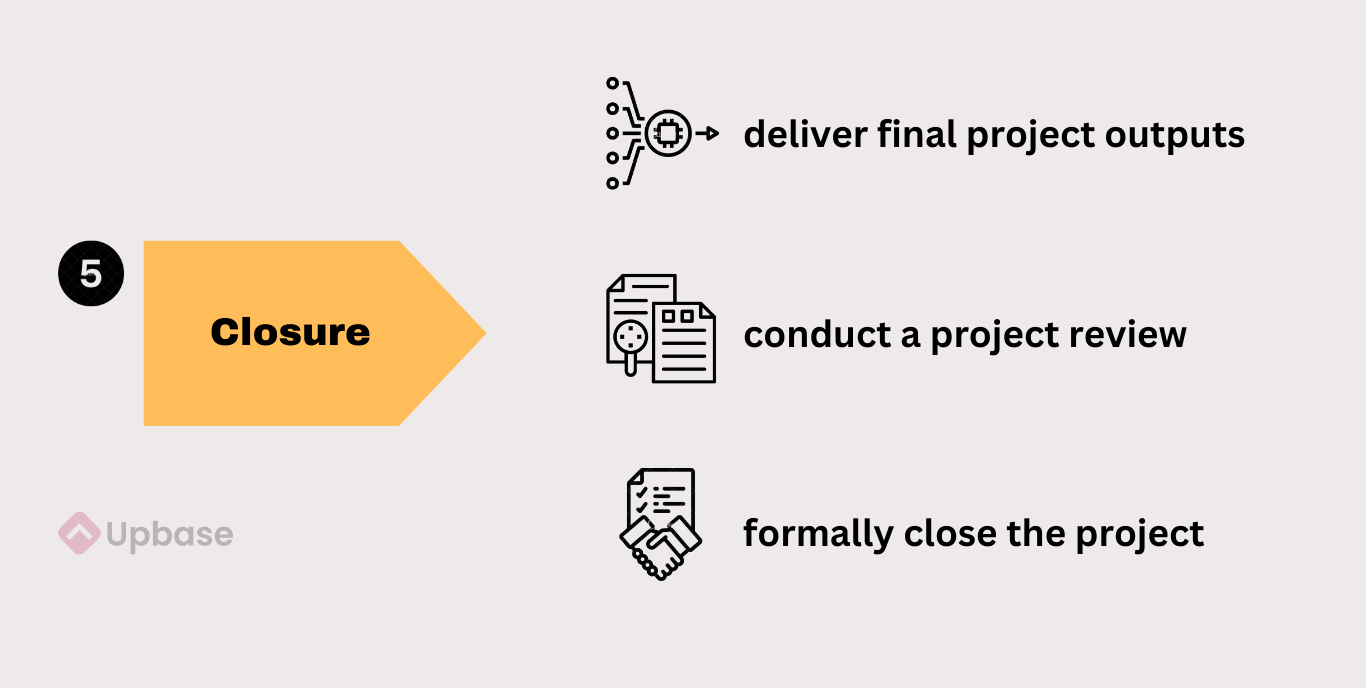
Deliver Final Project Outputs:
Ensure all deliverables outlined in the project’s scope are completed and delivered to the stakeholders. This could involve final reports, prototypes, or any other tangible outputs of the project.
Conduct a Project Review:
Gather your project team and stakeholders for a project review.
This is an opportunity to discuss what went well, what didn’t, and identify lessons learned. The insights gained can be invaluable for improving future project execution.
Formally Close the Project:
Don’t underestimate the importance of formally closing the project.
This involves finalizing documentation, releasing resources, and notifying stakeholders of the project’s completion.
A formal closure ensures a clean handover and avoids lingering loose ends.
II. Making it Work – Best Practices and Resources
Below are helpful practices, resources, and tools for managing projects more effectively:
1. Strategies for managing complexity:
Project management isn’t always sunshine and rainbows.
Sometimes, projects get messy – lots of moving parts, tangled tasks, and unexpected curveballs. This can make things complex and stressful.
But don’t worry, there are ways to fight complexity and keep your project running along. Here’s how:
Break Down Project Work Into Smaller Tasks
Large, looming tasks can feel overwhelming and paralyzing.
A key strategy for managing complexity is to break down projects or goals into smaller tasks. This creates a clearer workflow and makes the project seem less daunting.
Think of it like building with Legos – you wouldn’t try to build the entire spaceship in one go, you’d break it down into assembling smaller sections first.
Prioritize Tasks Effectively:
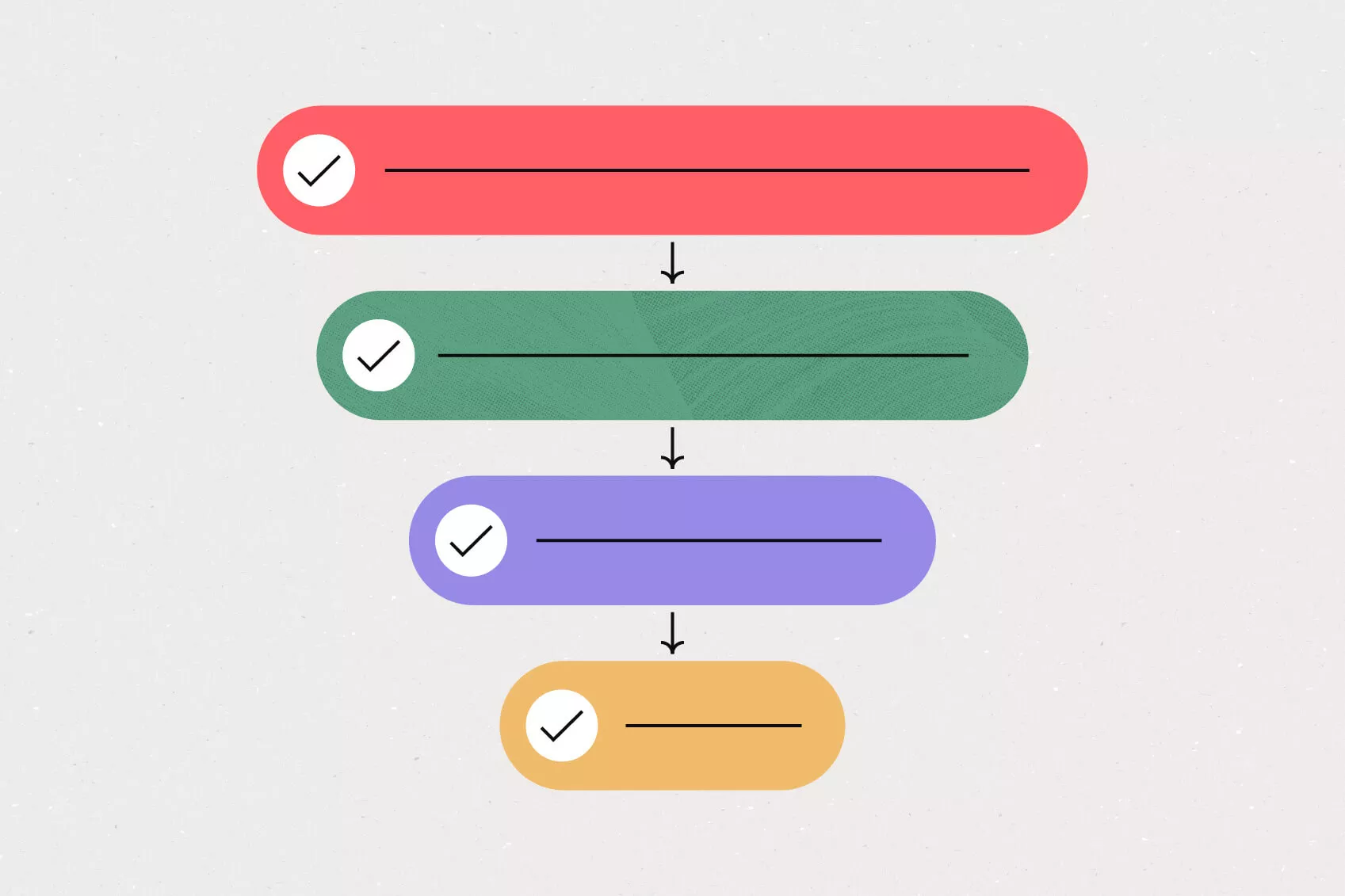
Not all the tasks are created equal. Some tasks are critical for project progress, while others can be tackled later.
Effective prioritization helps you focus on the most important tasks first and ensures you’re not wasting time on less critical activities.
There are various prioritization frameworks available, such as the Eisenhower Matrix, that can help you categorize and prioritize tasks based on urgency and importance.
2. Tips for effective communication management:
Clear and consistent communication is the lifeblood of completing a project successfully. It keeps everyone informed, aligned, and working towards the same project objectives.
However, with busy schedules and diverse project teams, communication breakdowns can easily occur.
Here are some practical tips to help you foster a communication plan in your projects:
Regular Team Meetings and Status Updates:

Schedule regular team meetings (daily stand-ups, weekly check-ins) to discuss project progress, address roadblocks, and ensure everyone is on the same page.
In addition to meetings, implement regular status updates through emails, project management tools, or communication channels preferred by your project team.
This keeps everyone informed and fosters a sense of transparency.
Clearly Defined Communication Channels:
Eliminate confusion by establishing clear communication channels for different purposes.
For example, you might use email for project updates, a team chat platform for quick questions, and dedicated channels for discussions on specific project aspects.
This helps avoid information overload and ensures messages reach the intended audience.
Utilize Project Management Tools for Collaboration:
Project management tools offer a plethora of features to streamline communication and collaboration.
These tools can include platforms for shared documents, task management boards, and real-time messaging functionalities.
By utilizing these tools effectively, you can facilitate discussions, centralize information, and ensure everyone has access to the latest project updates.
Remember: Effective communication is a two-way street. Actively listen to your team members and stakeholders, encourage open communication, and be receptive to feedback.
By following these tips, you can create a communication environment that fosters collaboration, transparency, and ultimately, project success.
III. Introducing Upbase – Your Best Tool for Project Management Activities:
So, you’ve got a handle on the core project management activities.
Now, let’s dive into a game-changing tool that can simplify these tasks and empower you to run your projects seamlessly: Upbase.
Upbase is an all-in-one project management software solution tailored specifically for individuals and small teams.
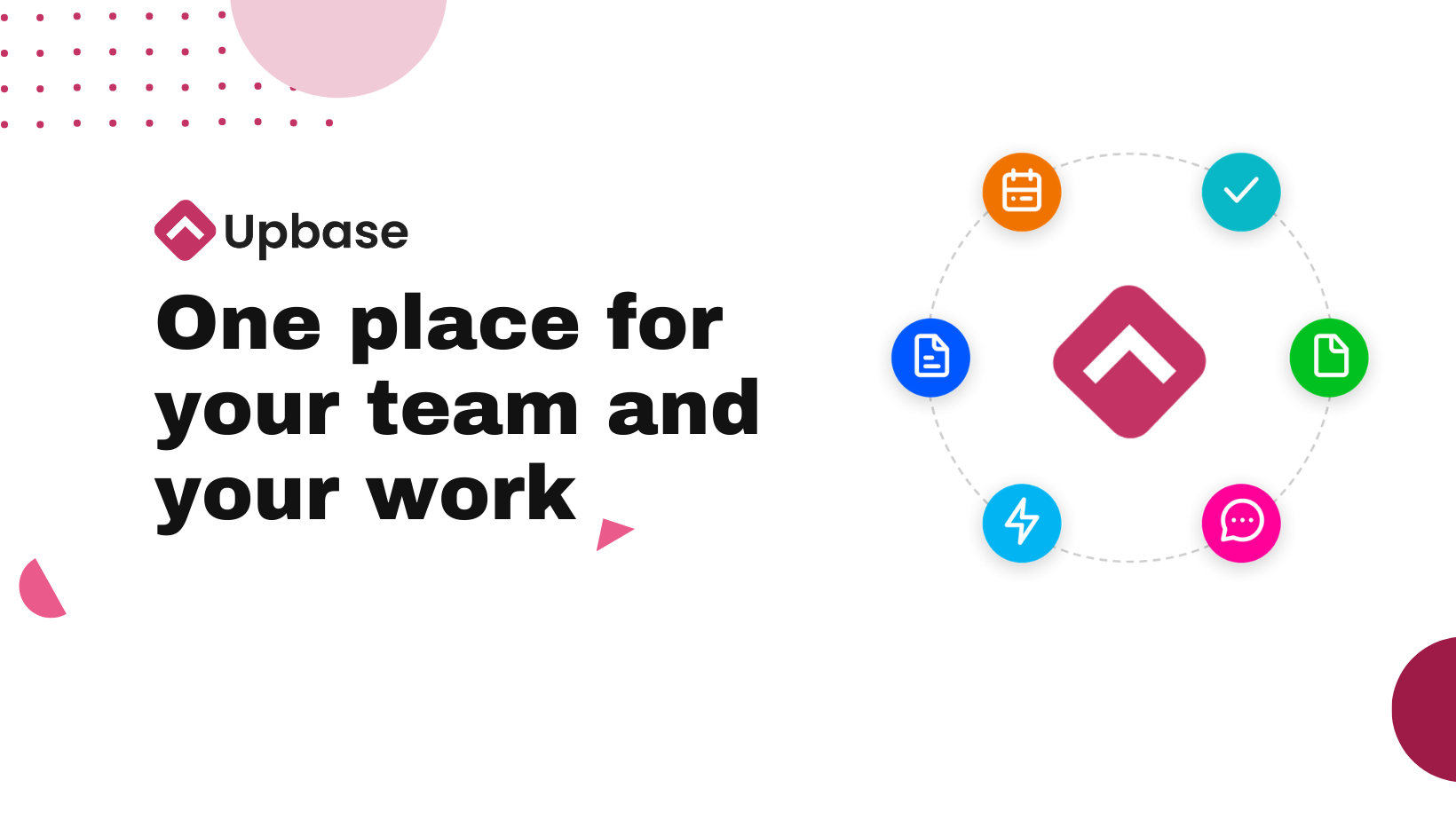
It strikes the perfect balance between robust features and user-friendliness, making it the ideal choice for anyone seeking to streamline their project workflow and enhance collaboration.
Importantly, it equips you with user-friendly features to navigate through each critical stage of project management.
Here are Upbase’s standout features for tackling project management activities:
1. “Docs” tool
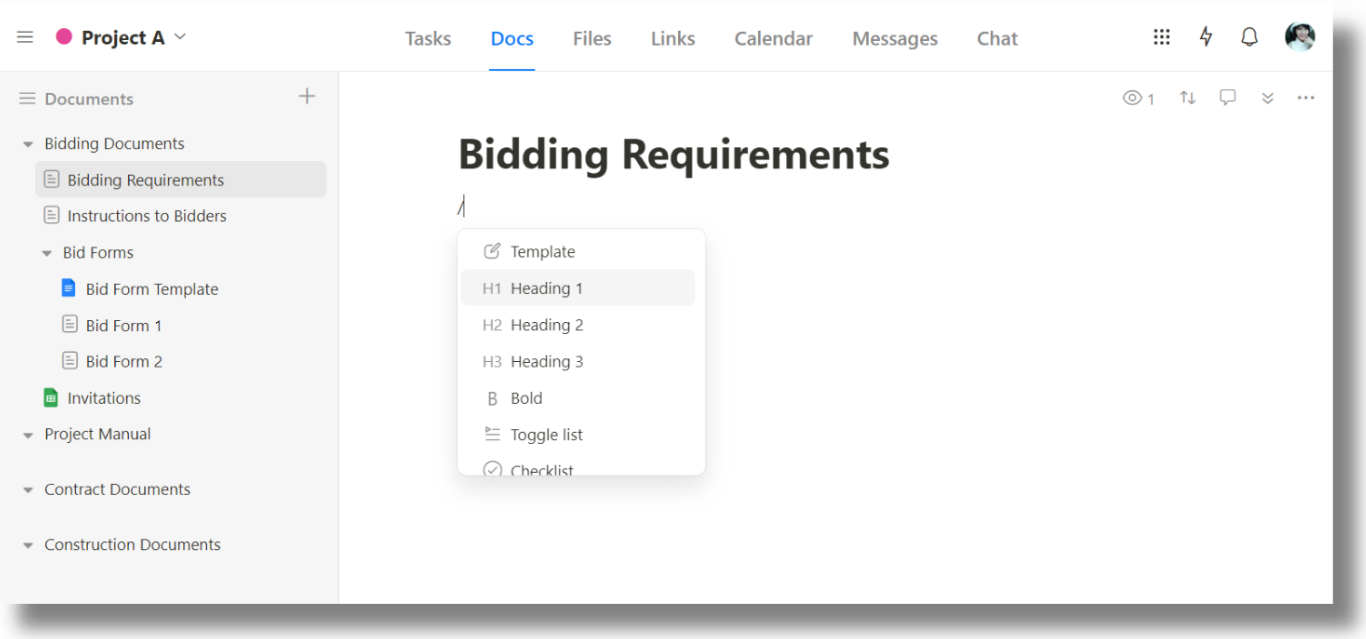
A powerful tool where you can create, edit, and organize documents, collaborate with team members, and embed Google Docs.
It’s ideal for brainstorming ideas, defining project goals, and outlining deliverables during the Initiation stage.
2. “Files” and “Links” tools
These tools, coupled with Docs, serve as a central repository for project files, documents, and links.
Easily deliver final outputs to stakeholders and ensure a seamless project handover.
The Files tool enables file upload, version management, embedding Google Drive folders, and collaboration, while also offering organization by folders for better file management.
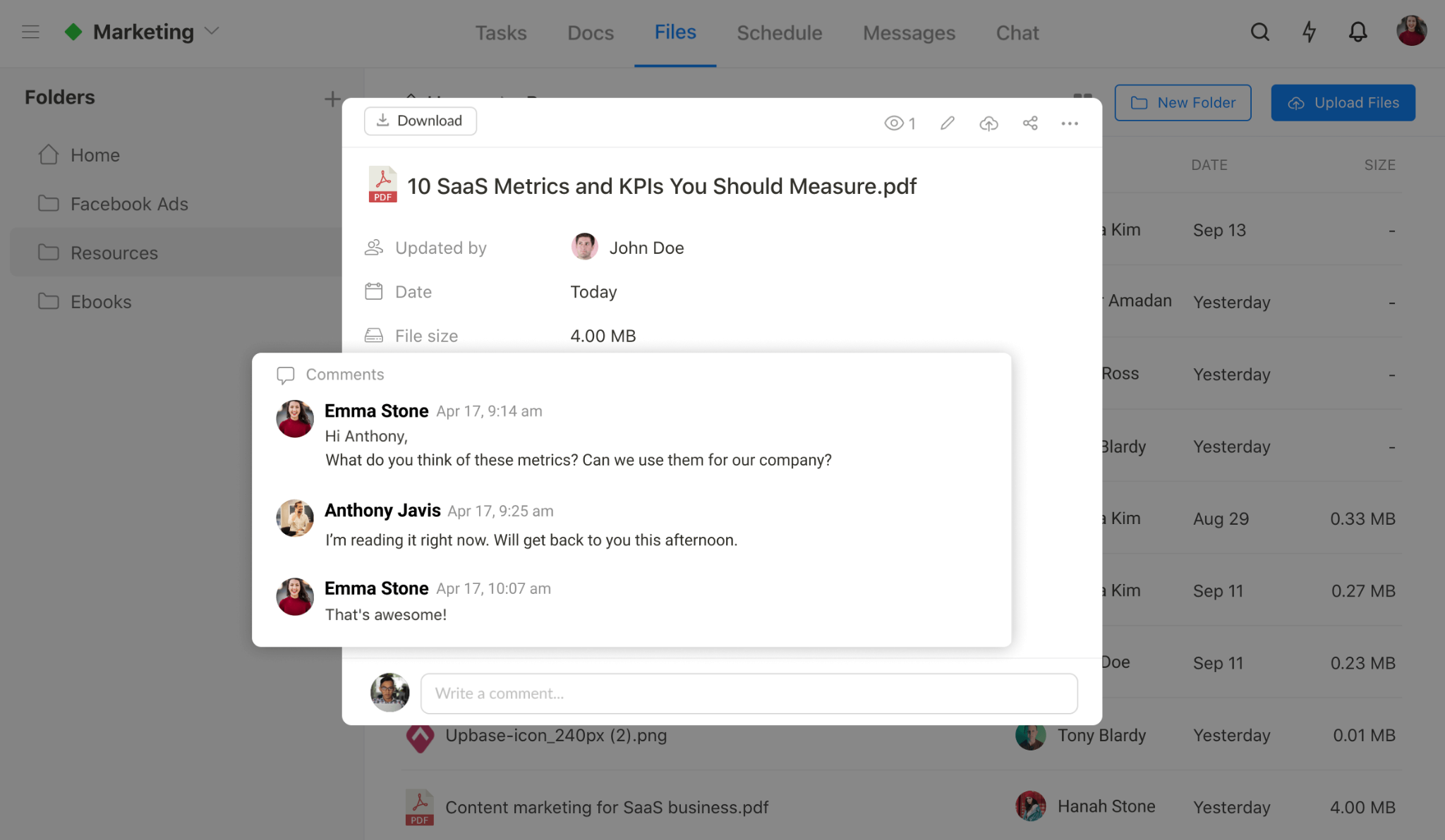
3. “Tasks” tool
A perfect tool to break down projects into manageable tasks and organize them during the Planning stage.
Tip: Project managers can take advantage of features like keyboard shortcuts and recurring tasks to enhance efficiency.
Not just so! In the Execution phase, you can assign tasks and subtasks to team members.
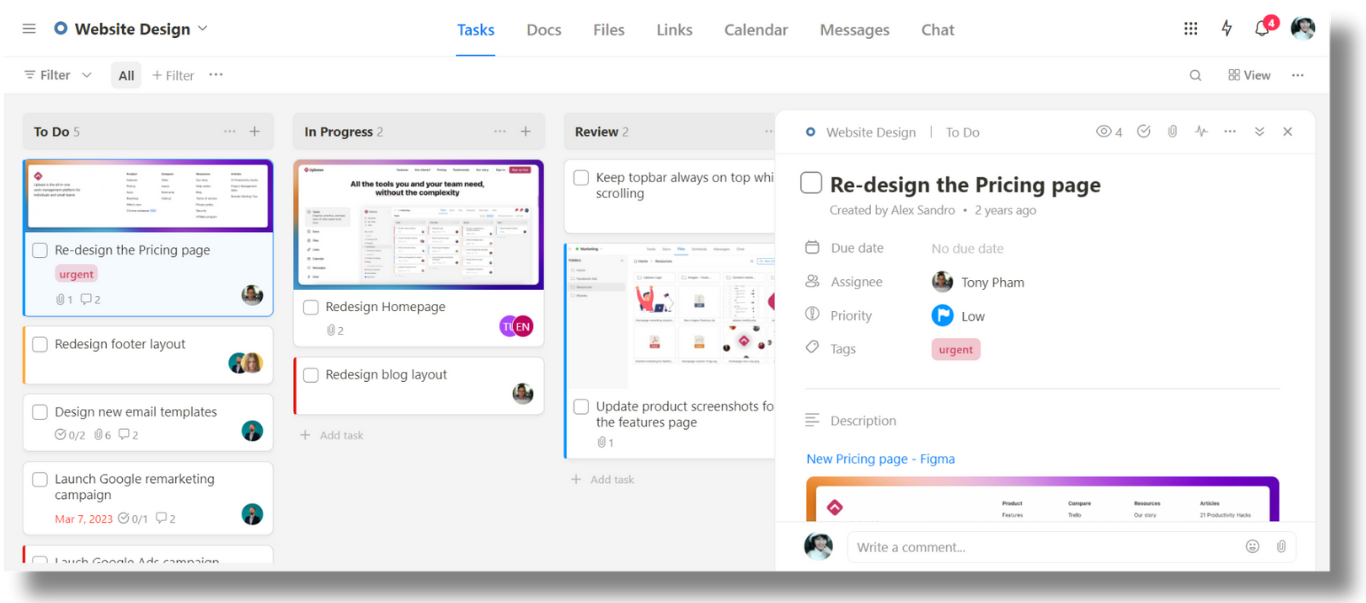
Use other features like task notes, attachments, priorities, deadlines, and tags to improve transparency – Everyone knows what’s expected of them, keeping projects moving forward.
List and Board views are helpful features to help you monitor project progress against the plan.
The custom filter feature is a game-changer.
With it, you can filter tasks within a project by different attributes such as assignees, tags, due dates, and priorities. This helps you focus on what truly matters and make better decisions.
For example, you can set up a custom filter for tasks assigned to a certain individual within the next 7 days to review their workload before deciding whether to assign them more tasks.
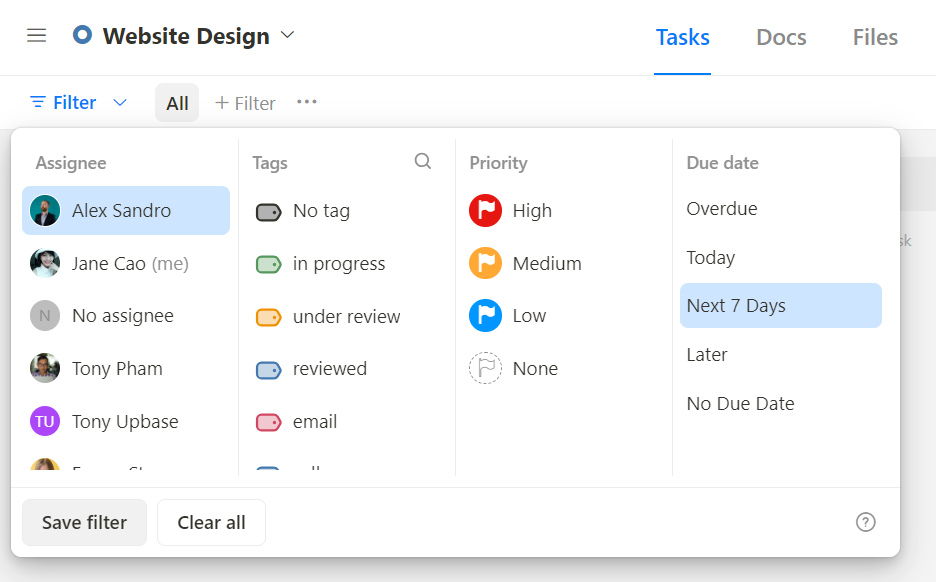
4. “Calendar” tool
A versatile tool for planning tasks, developing project schedules, and tracking progress across stages from planning to monitoring.
Upbase allows you to schedule tasks flexibly by week and month and easily adjust calendars in response to changes.
5. “Schedule” page
If your project team juggles multiple projects simultaneously, “Schedule” is a valuable tool. It provides an overview of tasks and deadlines color-coded by project.
Furthermore, you can sync your Google Calendar events for a unified view of tasks and events.
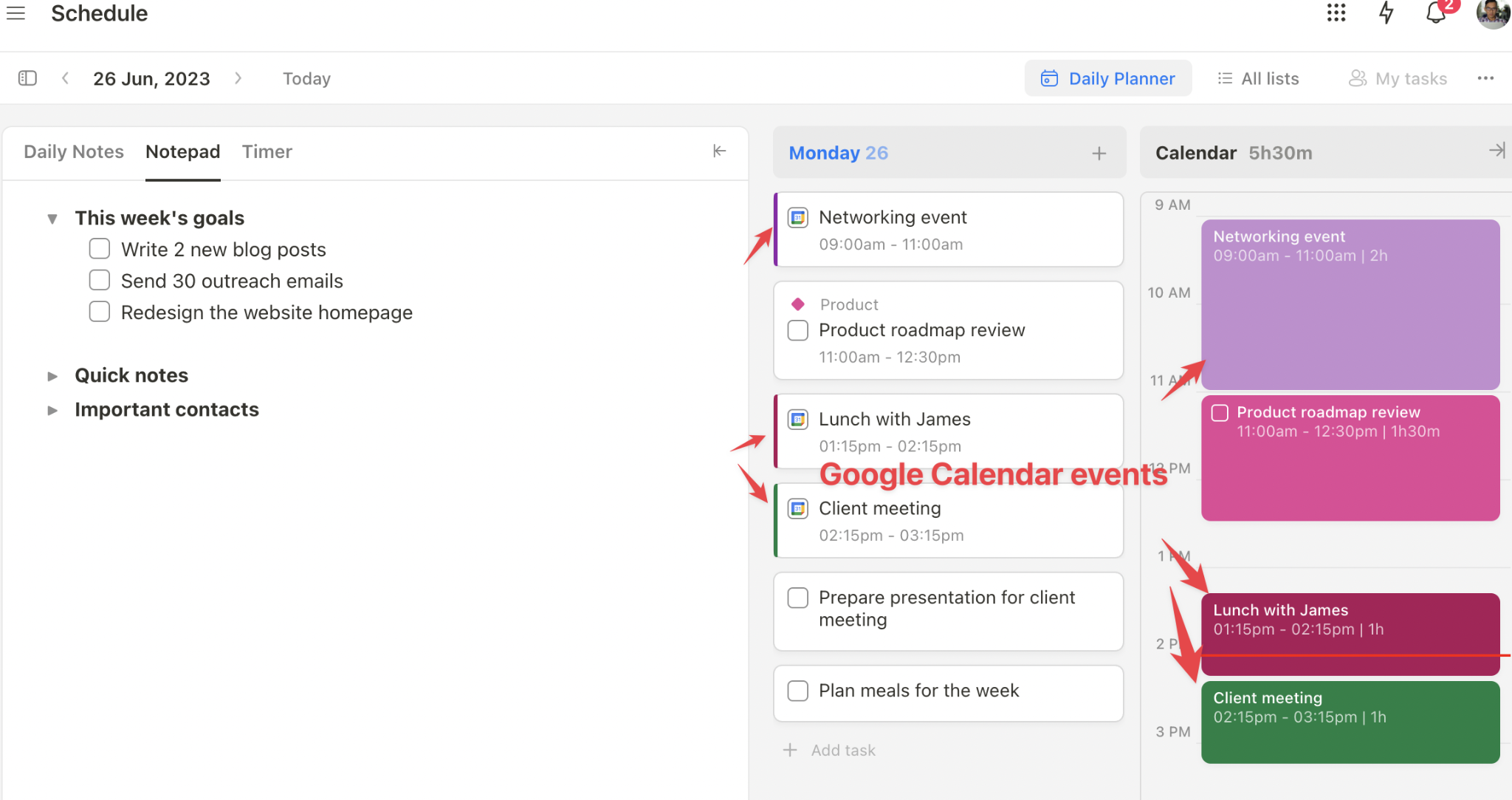
6. “Messages”, “Chat”, and Comments
This is one of Upbase’s strengths.
The project management software offers a wide range of dedicated tools to facilitate seamless communication between your team and stakeholders.
“Chat” supports instant messaging for both individual and group conversations, while “Messages” serve as an alternative to lengthy emails. It’s also an excellent platform for updating changes and collecting feedback from the team.
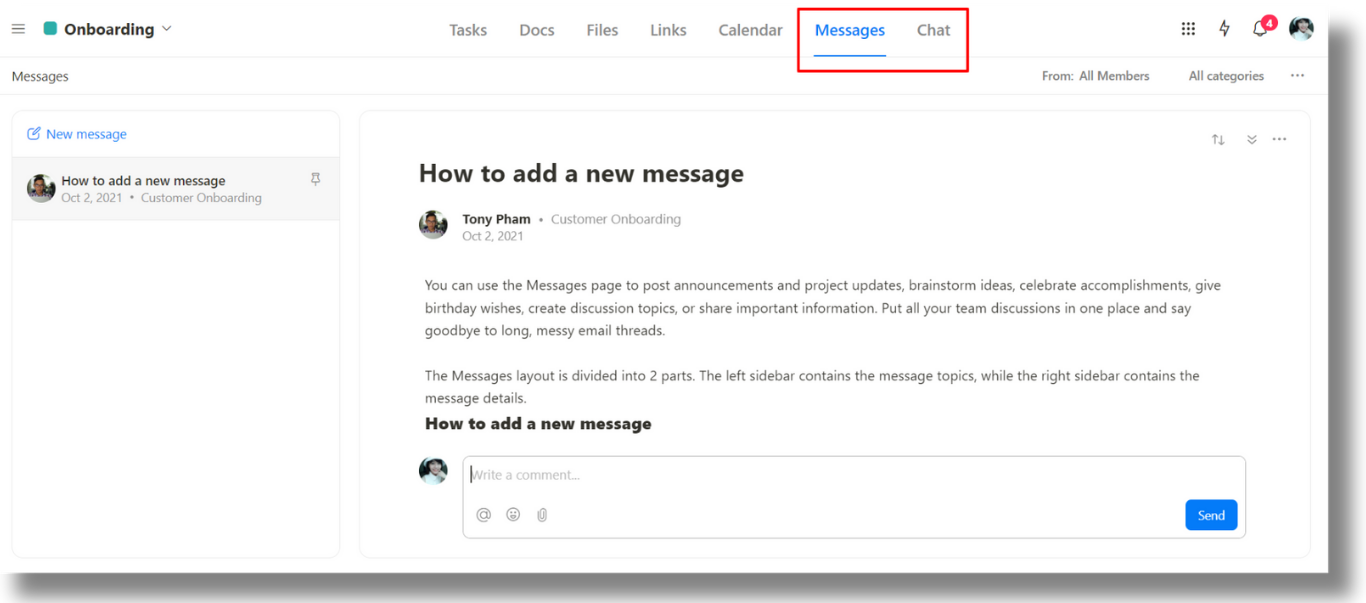
Additionally, you can add comments on tasks, files, documents, and links.
These features are invaluable for fostering open communication, maintaining seamless collaboration, and identifying problems early on for prompt solutions.
Upbase goes beyond being just a project management tool. It’s a collaborative hub that keeps your team connected, informed, and focused on achieving success.
Whether you’re tackling a small side project or managing a complex team effort, Upbase empowers you to streamline your workflow, boost productivity, and deliver projects on time and within budget.
And here’s a bonus:
Upbase offers a free version with unlimited tasks and users, allowing you and your team to give it a test drive without worrying about costs before making a decision. Sign up here!
Conclusion
The world of project management can be demanding, but it doesn’t have to be overwhelming.
By implementing effective strategies and utilizing the right tools, you can streamline project management activities, keep your team on track, and deliver successful projects.
Upbase emerges as a powerful ally in this journey.
It’s an all-in-one project management platform specifically designed for the needs of individuals and small teams.
Its intuitive interface, coupled with a rich set of features, empowers you to excel in every stage of project management, from initiation and planning to execution, monitoring, and closure.
So, why wait? Sign up today and see how Upbase can transform your project management journey!
FAQs
1. What are activities in project management?
Project management activities are the specific tasks and steps that make up a project’s life cycle, from the initial idea to final project completion.
These activities ensure all aspects of the project are planned, executed, and controlled effectively.
2. What are the five activities in project management?
The five essential project management activities include:
- Initiation: Defining the project’s objectives, scope, and stakeholders.
- Planning: Breaking down the project into tasks, creating a schedule, and allocating project resources.
- Execution: Carrying out the planned tasks, managing the team, and ensuring quality control.
- Monitoring & Control: Tracking project progresses, identifying deviations from the plan, and making adjustments as needed.
- Closure: Delivering final outputs, evaluating project success, and formally closing the project.
3. What are some project management tasks?
Project management tasks can vary depending on the project, but some common examples include:
- Create a project charter and scope document
- Identify and communicate effectively with project stakeholders
- Develop a project schedule and assign tasks
- Manage team communication and collaboration
- Track progress and create a risk management plan
4. What is an example of a project activity?
An example of a project activity could be “developing a marketing campaign plan” within the planning stage of a project for a new product launch.
This activity might involve tasks such as researching target markets, brainstorming creative concepts, and outlining a budget for marketing materials.
